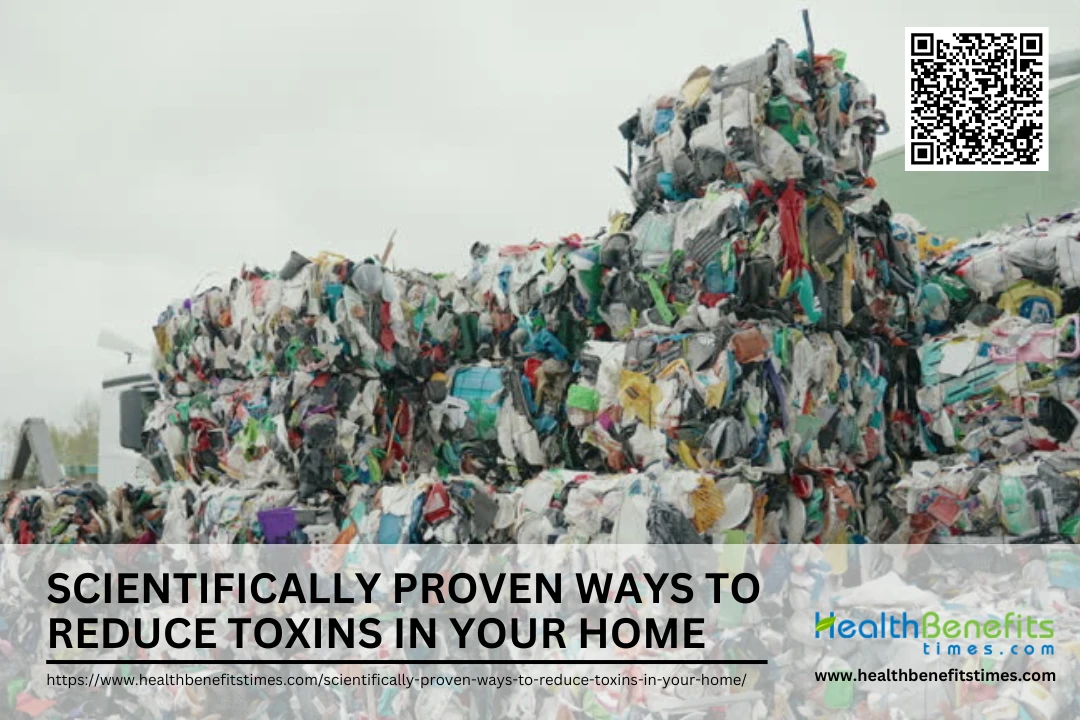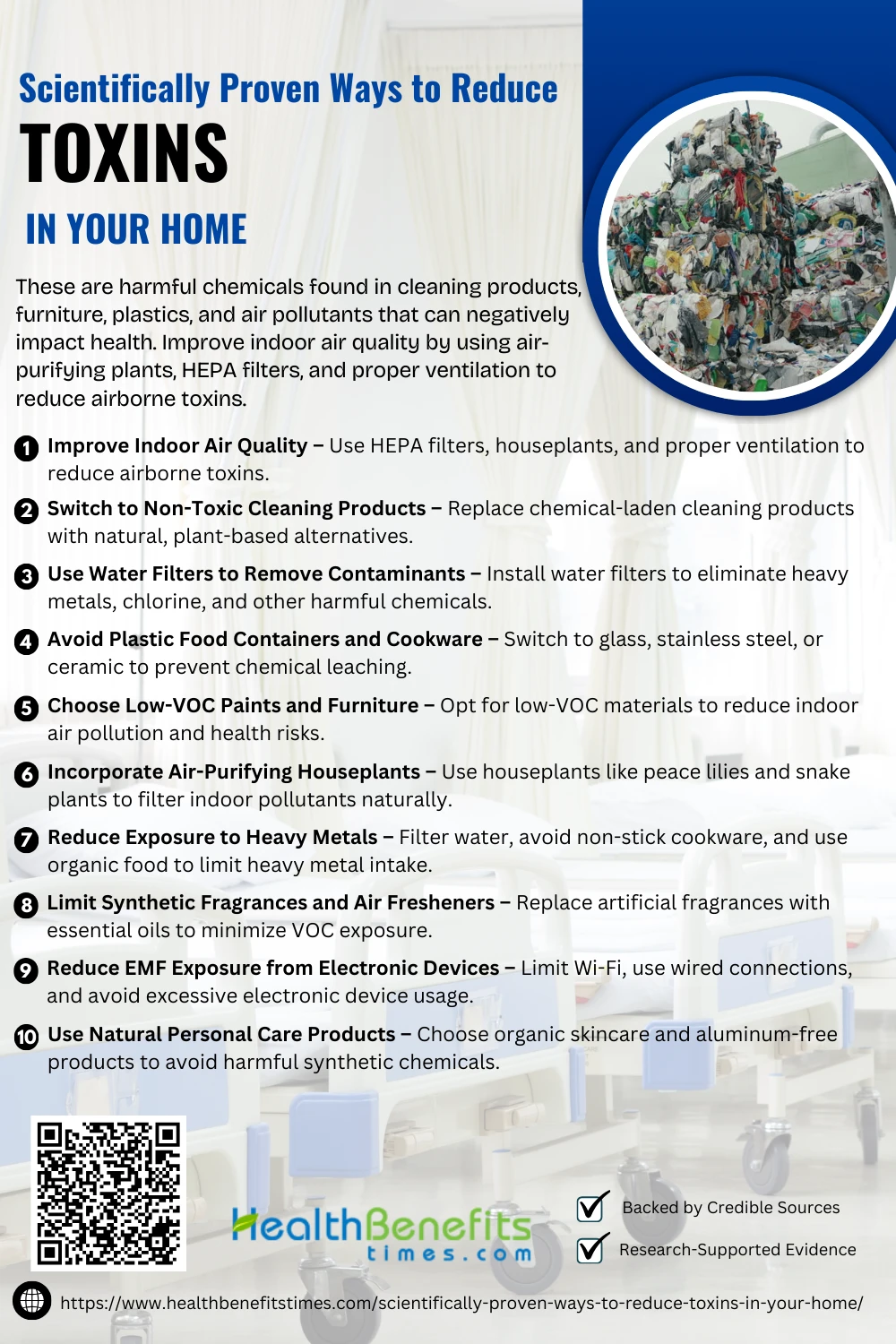- These are harmful chemicals found in cleaning products, furniture, plastics, and air pollutants that can negatively impact health.
- Improve indoor air quality by using air-purifying plants, HEPA filters, and proper ventilation to reduce airborne toxins.
- Choose non-toxic cleaning products, avoid plastics with harmful chemicals, and filter drinking water to minimize exposure to hazardous substances in your home.
 Household toxins are harmful substances commonly found in everyday household products, materials, and air, which can negatively impact human health and the environment. In modern homes, exposure to indoor pollutants such as volatile organic compounds (VOCs), per- and polyfluoroalkyl substances (PFAS), flame retardants, and synthetic chemicals in cleaning supplies and furniture is a growing concern. Studies indicate that prolonged exposure to these toxins can lead to respiratory diseases, hormone disruption, neurological impairments, and even cancer. A recent analysis of indoor air pollutants found that household dust contains significant levels of endocrine-disrupting chemicals, impacting child development and immune function. Furthermore, non-stick cookware and food packaging materials have been linked to bioaccumulative toxins that persist in the human body and the environment.
Household toxins are harmful substances commonly found in everyday household products, materials, and air, which can negatively impact human health and the environment. In modern homes, exposure to indoor pollutants such as volatile organic compounds (VOCs), per- and polyfluoroalkyl substances (PFAS), flame retardants, and synthetic chemicals in cleaning supplies and furniture is a growing concern. Studies indicate that prolonged exposure to these toxins can lead to respiratory diseases, hormone disruption, neurological impairments, and even cancer. A recent analysis of indoor air pollutants found that household dust contains significant levels of endocrine-disrupting chemicals, impacting child development and immune function. Furthermore, non-stick cookware and food packaging materials have been linked to bioaccumulative toxins that persist in the human body and the environment.
To combat these risks, scientific research supports actionable methods to minimize toxin exposure at home. Using HEPA air filters and ventilation systems can significantly reduce indoor air pollution and improve respiratory health. Opting for non-toxic, plant-based cleaning solutions has been shown to decrease indoor chemical exposure without sacrificing hygiene. Additionally, filtering tap water to remove contaminants such as lead, chlorine, and microplastics is recommended for maintaining safer drinking water standards. By making informed choices in household products, furnishings, and cleaning habits, individuals can create a safer, toxin-free home environment backed by scientific evidence.
Understanding Household Toxins
Common household toxins originate from various sources, including cleaning products, synthetic furniture, air fresheners, and non-stick cookware. Volatile organic compounds (VOCs) from paints and adhesives, heavy metals in drinking water, and flame retardants in furniture contribute significantly to indoor pollution. (1) Additionally, exposure to heavy metals such as lead, mercury, and arsenic, commonly found in tap water and certain household items, poses long-term health risks.
The health risks associated with household toxins are substantial, ranging from respiratory issues to neurodevelopmental disorders. Prolonged exposure to airborne pollutants and toxic chemicals can increase the risk of asthma, hormonal imbalances, and even certain cancers. (2) Furthermore, persistent organic pollutants found in household dust have been linked to endocrine disruption, affecting reproductive and immune systems. Reducing exposure through safer alternatives and proper ventilation is essential for maintaining a healthier indoor environment.
Scientifically Proven Ways to Reduce Toxins in Your Home
Your home may contain hidden toxins from cleaning products, furniture, and air pollutants. Discover scientifically proven ways to reduce harmful chemicals, improve air quality, and create a healthier living environment.
1. Improve Indoor Air Quality
Enhancing indoor air quality is crucial for minimizing exposure to harmful toxins such as volatile organic compounds (VOCs), mold spores, and particulate matter. Research indicates that using high-efficiency particulate air (HEPA) filters and air purifiers can significantly reduce indoor pollutants, improving respiratory health. (3) Additionally, houseplants like spider plants and peace lilies have been found to absorb airborne toxins effectively. (4) Opening windows regularly helps dilute indoor pollutants and increase ventilation. (5) Moreover, reducing indoor humidity levels prevents mold growth, which contributes to air contamination. (6)
2. Switch to Non-Toxic Cleaning Products
Conventional personal care products often contain synthetic chemicals such as parabens, phthalates, and artificial fragrances, which have been linked to hormone disruption, skin irritation, and long-term health risks. Studies show that natural personal care products made with botanical ingredients, essential oils, and organic compounds significantly reduce toxin exposure. (7) Research highlights that heavy metals, including lead and cadmium, are commonly found in commercial beauty soaps and cosmetics, further emphasizing the need for safer alternatives. (8) A study demonstrated that herbal-based skincare solutions offer antimicrobial benefits without introducing synthetic toxins. (9) Furthermore, avoiding conventional deodorants and opting for aluminum-free alternatives helps prevent heavy metal accumulation in the body. (10) Lastly, switching to organic shampoos and fluoride-free toothpaste has been associated with lower levels of endocrine-disrupting chemicals in human biomonitoring studies. (11)
3. Use Water Filters to Remove Contaminants
Water filtration is essential for removing harmful contaminants such as lead, chlorine, PFAS, and heavy metals from drinking water. Studies confirm that activated carbon filters effectively reduce toxic chemicals and improve water safety. (12) Advanced filtration technologies, like electrochemical systems, enhance contaminant removal while reducing chemical dependency. (13) Additionally, nanomaterial-based filters offer selective removal of heavy metals, ensuring cleaner water for households. (14) Whole-house filtration systems can eliminate various pollutants, including pharmaceuticals and industrial chemicals, from tap water. (15) A study also found that community-wide adoption of water filters significantly lowers toxin exposure and improves public health outcomes. (16)
4. Avoid Plastic Food Containers and Cookware
Plastic food containers and non-stick cookware can leach harmful chemicals like bisphenol A (BPA), phthalates, and perfluorooctanoic acid (PFOA) into food, contributing to health risks. Research indicates that heat exposure accelerates chemical migration from plastic containers into food. (17) Glass, stainless steel, and silicone alternatives significantly reduce toxin exposure while maintaining food quality. Studies show that cast-iron and ceramic cookware prevent the release of endocrine-disrupting compounds found in Teflon-coated products. (18) Moreover, replacing plastic with safer alternatives helps decrease microplastic contamination in the diet. (19) The long-term use of plastic-free kitchenware has been associated with lower levels of synthetic chemicals in human biomonitoring studies.
5. Choose Low-VOC Paints and Furniture
Low-VOC (volatile organic compound) paints and furniture significantly reduce indoor air pollution and improve overall indoor air quality. Research shows that VOC emissions from traditional paints and varnishes contribute to respiratory issues and neurological disorders. (20) Opting for low-VOC or zero-VOC alternatives minimizes exposure to toxic chemicals found in conventional finishes. (21) Furthermore, studies highlight that furniture made from untreated wood or natural materials is safer as it reduces off-gassing of harmful compounds. (22) A case study found that homes with low-VOC materials showed a significant decrease in indoor air pollutants. (23) Additionally, using natural fiber textiles and non-toxic adhesives helps maintain a toxin-free environment. (24)
6. Incorporate Air-Purifying Houseplants
Houseplants act as natural air filters, reducing harmful indoor pollutants such as benzene, formaldehyde, and carbon monoxide. Studies confirm that common houseplants like peace lilies, snake plants, and pothos significantly lower airborne toxins. (25) NASA’s Clean Air Study identified plants that absorb and neutralize VOCs, improving indoor air quality. (26) Research also suggests that indoor plants contribute to a healthier home environment by reducing stress and improving oxygen levels. (27) Moreover, incorporating greenery indoors is linked to enhanced cognitive function and lower stress levels in urban dwellers (Polk, 2018). Lastly, phytoremediation—the use of plants to clean air—has been recognized as a sustainable, cost-effective method to eliminate indoor toxins. (28)
7. Reduce Exposure to Heavy Metals
Heavy metals such as lead, mercury, cadmium, and arsenic can accumulate in household dust, water, and food sources, leading to long-term health effects. Research indicates that using activated carbon and reverse osmosis water filters can significantly reduce heavy metal contamination in drinking water. Additionally, avoiding cookware with non-stick coatings containing heavy metal residues reduces exposure. (29) Choosing organic foods and thoroughly washing produce helps minimize dietary intake of toxic metals. (30) Research also highlights that regular home cleaning and using HEPA vacuum filters can effectively reduce indoor heavy metal particulates. (31) Moreover, replacing lead-based paints and old plumbing fixtures is crucial for lowering household exposure. (32)
8. Limit Synthetic Fragrances and Air Fresheners
Synthetic fragrances found in air fresheners, perfumes, and cleaning products emit volatile organic compounds (VOCs) that can cause respiratory irritation and disrupt hormones. Studies show that many fragrance chemicals contain endocrine-disrupting compounds linked to allergic reactions and asthma. (33) Research also reveals that scented air fresheners release harmful secondary pollutants when reacting with ozone indoors. (34) Additionally, eliminating synthetic fragrance products from homes has been associated with improved indoor air quality and reduced health risks. (35) Switching to essential oil-based diffusers and natural room fresheners helps create a healthier home environment. (36) Research also suggests that fragrance-free policies in workplaces and homes significantly lower exposure to toxic airborne chemicals. (37)
9. Reduce EMF Exposure from Electronic Devices
Electromagnetic field (EMF) exposure from electronic devices such as Wi-Fi routers, smartphones, and household appliances has been linked to potential health concerns, including sleep disturbances, oxidative stress, and endocrine disruption. Research suggests that reducing EMF exposure by turning off Wi-Fi at night, using wired connections, and keeping electronic devices away from the body can mitigate risks. (38) Shielding materials and EMF-reducing technologies have also been proven effective in minimizing exposure levels. (39) A study demonstrated that children with lower EMF exposure had improved cognitive function and sleep quality. ({% https://www.nature.com/articles/s41598-022-13172-3 trusted %}) Additionally, limiting the use of wireless baby monitors and smart home devices has been recommended to reduce EMF absorption in young children.
10. Use Natural Personal Care Products
Conventional personal care products often contain synthetic chemicals such as parabens, phthalates, and artificial fragrances, which have been linked to hormone disruption, skin irritation, and long-term health risks. Studies show that natural personal care products made with botanical ingredients, essential oils, and organic compounds significantly reduce toxin exposure (Nagendran et al., 2025). (7) Research highlights that heavy metals, including lead and cadmium, are commonly found in commercial beauty soaps and cosmetics, further emphasizing the need for safer alternatives. (8) A study demonstrated that herbal-based skincare solutions offer antimicrobial benefits without introducing synthetic toxins. (9) Furthermore, avoiding conventional deodorants and opting for aluminum-free alternatives helps prevent heavy metal accumulation in the body. (10) Lastly, switching to organic shampoos and fluoride-free toothpaste has been associated with lower levels of endocrine-disrupting chemicals in human biomonitoring studies. (11)
Conclusion
Reducing toxins in your home is a step-by-step process that leads to a healthier environment for you and your family. By improving air quality, choosing non-toxic products, filtering water, and minimizing harmful chemicals in everyday items, you can significantly lower your exposure to pollutants. Small, conscious changes—like using natural cleaners, avoiding plastics, and opting for organic alternatives—can have a lasting impact on your well-being. Prioritizing a toxin-free home not only benefits your health but also contributes to a more sustainable lifestyle. Start with simple swaps and build healthier habits for a cleaner, safer living space.



